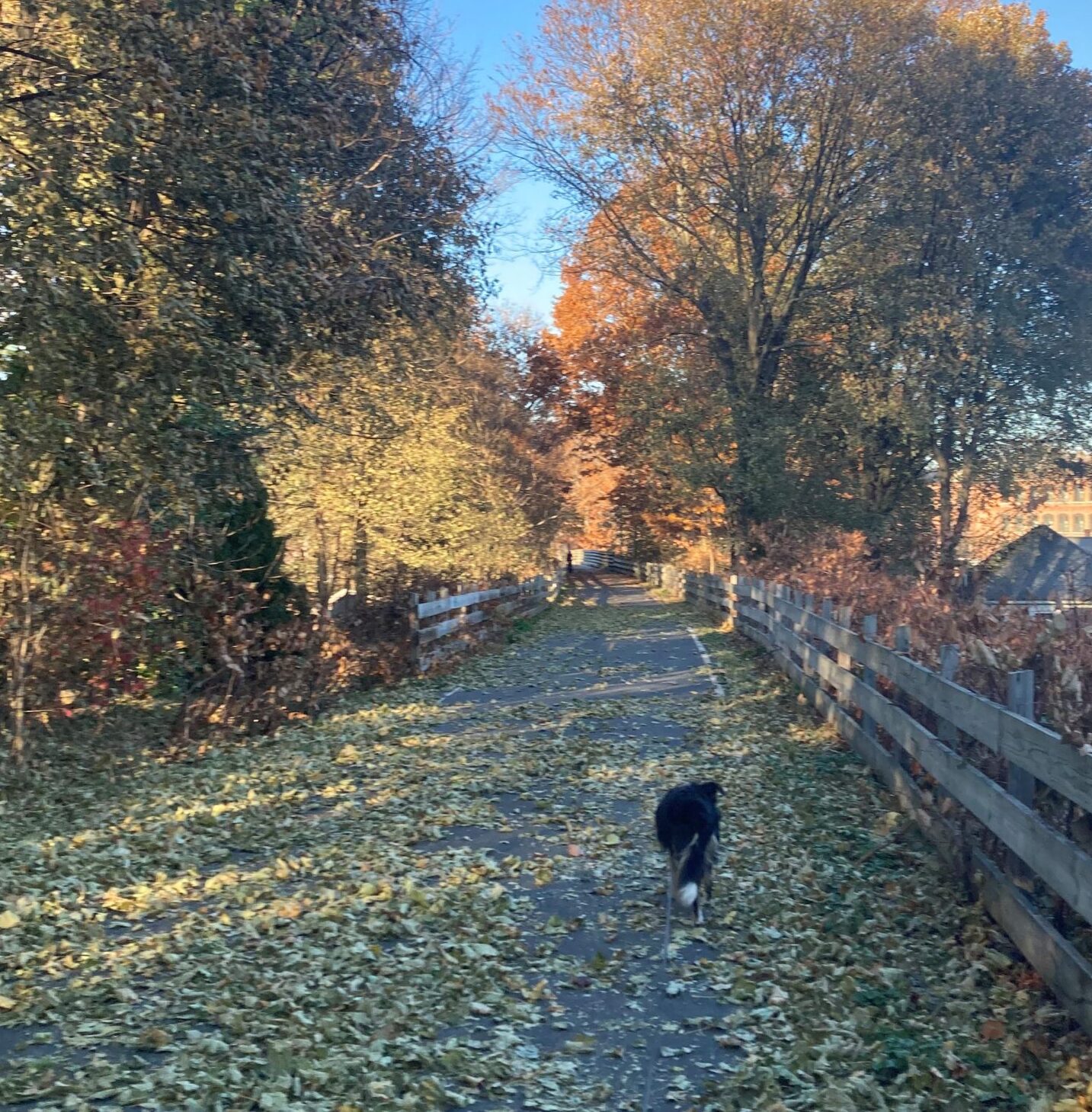Winter is an etching, spring a watercolor, summer an oil painting and autumn a mosaic of them all.
-Stanley Horowitz
Meanwhile, back at the Marlborough Rail Trail, the leaves have finally fallen from the trees. Fractal stick-figure fingers reach for the sky and leave a thick blanket of orange and tan, dead and rotting, leaves on the ground below. The temperatures are still jumping all over the scale and Waldo and I often wait for the afternoon, for warmer temperatures, before we start our walk. Sometimes, we wait too long and we can’t finish before dark. That’s not very hard to do since sunset is now around 4:30 PM. Today is one of those days.
We walk along, Waldo out in the lead as always, in the long shadows of late afternoon. I’m dressed in a hoodie and my rain jacket and I’m wearing light-weight gloves. It’s warm enough. Waldo, seemingly more comfortable in the cooler temperatures, trots along, carrying his ubiquitous stick. He’s doing his Waldo thing and I, well, my mind wanders.
Over the past month or so, I’ve watched leaves go from green to a dull orange and yellow. Then parts of maples let loose their brilliant reds and bright oranges and the oaks turn a splotchy tan. I watch and wait, wondering which of the deciduous trees will be the last to hang onto their leafy shawls. All seem to lose their photosynthetic food-source from the bottom up. Maybe they’re hanging the longest onto those that are most exposed to the sun and its life-giving light. Leaves fell for weeks, yet, for a long while, some trees still seemed quite green. Even in four inches of snow. After that, there were more weeks where plenty of oak leaves lay on the ground, yet their source canopies remained broad and full, although quite tan. It’s as if nature was culling the foliage to make room for the strong. Then, over no more than a couple of days, leaves flew like fur in a cat fight. After that, branches became bare, except for a very few die-hard, brown hangers-on. As far as I could tell, the last to go naked were the oaks and maples, but they seemed to keep to the same schedule.
White pine is a New England native conifer and there are some around our trail. These keep our walks ever green, but there aren’t so many of them that it feels like we’re in a lush verdure. Their needles give a light pine-green stippled tinge to vistas instead of the heavy broad-stroked, opaque, dark forest-green of leafy mid-summer. Now stripped of their veils, trees reveal defoliated stalks of poison ivy, and other vines I’ve yet to identify, winding their way up many a trunk. Some are large and as thick as your arm, while others are mere straw-sized tendrils twisting around anything that rises from the ground. There seem to be more of them near the trail, quickly dropping off to none, thirty feet or so away. Maybe they need the sunlight provided by the relative openness of the tarmac. The puffy green blanket of summer now lies flat, yellow and tan on the ground and you can clearly see the skeletal core of the forest.
As the afternoon progresses, shadows lengthen until what light there is becomes diffuse and gray, causing the contrast of light and shadow to blur and making the world seem two-dimensional. Just after sunset, the air near the western horizon glows with a peachy hue that fades to orange and then blue as your eye tracks overhead and then to the east. It’s not long, about a half-hour after the sun has disappeared, and even this fades to darkness. It’s not the abysmal ebony of moonless, cloudy nights deep in primordial forests far from civilization. Even though the rail trail doesn’t have lights, the ambient city glow provides some low-level light — enough so I can see where I’m going without too much difficulty. The shades of gray that make up the night are a black-and-white rendition of the pastel late autumn tints of daytime. But, like black-and-white photographs, the scene has a beauty of its own. Waldo, mostly black as he is, though, is lost to view as he explores under the bushes on the side of the trail. He can see better in the dimness than I can and doesn’t seem to notice much of a change. But then, why would he when he sees the world through his nose? I wonder if things smell different after the sun goes down. Maybe so. The temperature and humidity changes could make a difference.
In not too many days or weeks, all will be monotonously gray and white, even in daytime, with only an overhead icy, deep blue to add color to the world.
I will miss fall.



